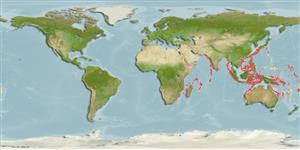Common names from other countries
>
Perciformes/Bembropoidei (Duckbill flatheads) >
Bembropidae (Duckbill flatheads)
Etymology: Bembrops: Greek, bembras, -ados = a kind of anchovy m+ Greek, ops = appearance (Ref. 45335); platyrhynchus: Specific name from the Greek 'platys' meaning flat and 'rhynchos' meaning snout or beak..
More on author: Alcock.
Environment: milieu / climate zone / depth range / distribution range
Ecología
marino batidemersal; rango de profundidad 200 - 549 m (Ref. 26165). Deep-water
Indo-West Pacific: including the Bay of Bengal, the South China Sea, the Philippine Sea, the Tasman Sea, and off the coast of Somalia and South Africa.
Tamaño / Peso / Age
Maturity: Lm ? range ? - ? cm
Max length : 25.0 cm TL macho / no sexado; (Ref. 6652)
Espinas dorsales (total): 6; Radios blandos dorsales (total): 14-15; Espinas anales 0; Radios blandos anales: 15 - 16. Vague dusky spots along body, 1 on caudal fin at base of upper rays; scales edged with black; 1st dorsal fin dusky to black in color (Ref. 6652). Distal margin of first dorsal fin darkish. Usually 5 scale rows between lateral line and origin of anal fin (Ref 12932).
Inhabits offshore trawling grounds (Ref. 3132).
Life cycle and mating behavior
Madurez | Reproducción | Puesta | Huevos | Fecundidad | Larva
Das, M.K. and J.S. Nelson, 1996. Revision of the percophid genus Bembrops (Actinopterygii: Perciformes). Bull. Mar. Sci. 59(1):9-44. (Ref. 13203)
IUCN Red List Status (Ref. 130435)
CITES (Ref. 128078)
Not Evaluated
Threat to humans
Harmless
Human uses
Más información
ReferenciasAcuiculturaPerfil de acuiculturaRazasGenéticaElectrophoresesheritabilidadEnfermedadesProcesamientoMass conversion
ColaboradoresImágenesStamps, Coins Misc.SonidosCiguateraVelocidadTipo de nataciónSuperficie branquialOtolitosCerebrosVisión
Herramientas
Special reports
Download XML
Fuentes de Internet
Estimates based on models
Preferred temperature (Ref.
115969): 9.8 - 17.3, mean 12.5 (based on 197 cells).
Phylogenetic diversity index (Ref.
82804): PD
50 = 0.5000 [Uniqueness, from 0.5 = low to 2.0 = high].
Bayesian length-weight: a=0.00363 (0.00177 - 0.00744), b=3.12 (2.94 - 3.30), in cm Total Length, based on LWR estimates for this species & (Sub)family-body (Ref.
93245).
Nivel trófico (Ref.
69278): 4.1 ±0.5 se; based on size and trophs of closest relatives
Fishing Vulnerability (Ref.
59153): Low vulnerability (15 of 100).
